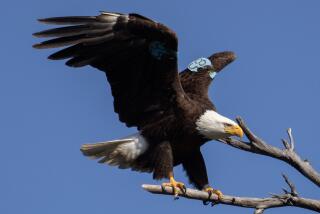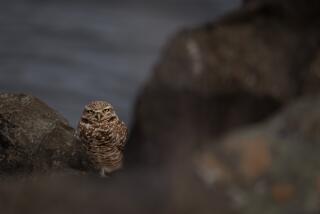See the bald eagle chicks: Pair hatch over two days in Big Bear

A Big Bear bald eagle helps its chicks hatch out of their shell.
Big Bear residents and fans from around the globe were riveted by a live webcam broadcast of a pair of bald eagle hatchlings who broke free from their eggs and came into the world over the last two days.
The two chicks — one hatched Sunday, the other on Monday — made their debut in a nest about 120 feet off the ground near the top of a Jeffrey pine on the north side of Big Bear Lake. A bald eagle whom locals named Jackie laid the two eggs on March 6 and 9.
Jackie spent most of Monday morning sitting on top of the pair, although she occasionally got up and fed them pieces of a nearby fish. The chicks’ down no longer appeared sticky and wet by early Monday afternoon.
Viewers glued to the webcam placed by the Friends of Big Bear Valley got occasional views of the young birds’ fluffy tufts of light-colored down. Some Facebook commenters chided the male in the nest, Shadow, for not bringing the new mother fresh fish to feed the chicks.
Fans of the eagles will have to enjoy the avian family through a screen. The nest is high off the ground, and the surrounding neighborhood of Fawnskin is off-limits to the public in order to prevent the birds from being spooked by onlookers.
“If there are people in the area, the parents could abandon the nest and the young,” said Zach Behrens, a spokesman for the San Bernardino National Forest.
Including the two new hatchlings, there are at least 15 bald eagles in the area. An annual count this winter that covered five lakes in the San Bernardino National Forest, and two California State Park recreation areas found at least 13 of the giant birds of prey.
The eagles near Fawnskin are local celebrities and also are at the center of a debate about development near one of Southern California’s most visited lakes. The area is home to nesting sites that have been used by the eagles for years.
The hatchlings will stay in the nest while they learn to fly and hunt over the spring and summer before taking off on their own.
More to Read
Start your day right
Sign up for Essential California for news, features and recommendations from the L.A. Times and beyond in your inbox six days a week.
You may occasionally receive promotional content from the Los Angeles Times.







